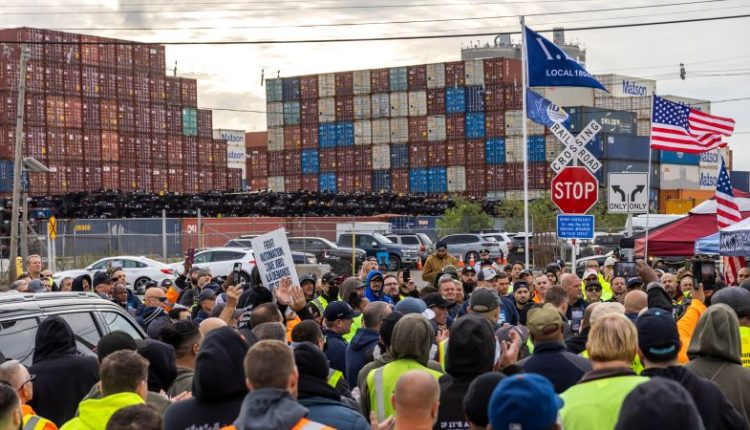A version of this story appeared in CNN Business’ Nightcap newsletter. To get it in your inbox, sign up for free, here.
The dockworkers striking up and down the East Coast are, culturally and geographically, a world apart from the Hollywood actors and writers who staged a four-month walkout last year. But their protests share a common core principle: They don’t want bots taking their jobs.
It’s a fight you can expect to see playing out a lot more as advanced automation and AI creep into virtually every workforce.
Here’s the deal: The East Coast port strike is getting a lot of attention for its potential disruption to the economy — which is precisely the point. Longshore work can be grueling, and the people working at ports are vital to getting all of the stuff we want to buy onto store shelves. No dockworkers means no bananas (or whatever), which means no profits for the companies that produce and ship them.
The strike that began early Tuesday is about two main issues: wages and automation. Around the ports, workers can be seen wearing signs that read “robots don’t pay taxes” and “automation hurts families.”
They’re fighting a trend that port operators largely want to see accelerate: more cranes and driverless trucks shuttling goods from container ships, with fewer humans around demanding compensation.
Of course, the economics of automation aren’t so simple. While research shows automation has obvious benefits, like lower operating costs and fewer human-related errors, port automation does not, on its own, significantly improve performance, according to a 2018 McKinsey report.
Automated ports “are generally less productive than their conventional counterparts,” and the return on their significant capital investments falls short of the industry norm, according to industry leaders surveyed by McKinsey. (The report does note, however, that “careful planning and management” can overcome those challenges.)
Still, automation is clearly a trend, and US shipping executives seem to be eyeing modern ports in China, Singapore and Europe with envy.
“The rest of the world is looking down on us because we’re fighting automation,” said Dennis Daggett, executive vice president of the International Longshoremen’s Association, outside the Port of New York and New Jersey Tuesday morning. “Remember that this industry, this union has always adapted to innovation. But we will never adapt to robots taking our jobs.”
The dockworkers’ concerns are legit.
Automation won’t end the need for human labor completely, but it will significantly reduce the number of bodies needed on payroll, just as it has done in many industries, including auto manufacturing and mining. One report from the Economic Roundtable found that automation eliminated 572 full-time roles at the ports of Long Beach and Los Angeles in 2020 and 2021.
The longshoremen’s union is demanding a $5-an-hour increase in pay in each of the six years over the course of the next contract and “airtight” language that the ports won’t introduce automation “or semi-automation.”
The displacement of automation is a familiar trope in the history of blue-collar work, and it became a central sticking point in last year’s Hollywood strikes as actors and writers try to protect their creative work from being duplicated by artificial intelligence.
But automation anxiety is rapidly spilling over into office work, where managers are adopting AI in the hopes of replacing human work or amplifying production.
Over the summer, a survey of large US firms found that more than 60% plan to use AI within the next year to automate tasks previously done by employees.
Sameera Fazili, former deputy director of the National Economic Council in the Biden administration, said workers largely aren’t saying “no” to all automation but rather that they want a voice in shaping how it becomes part of the workplace. And that anxiety is part of what’s driving growing interest in labor organizing.
“This is all happening in an environment where, it’s not like CEOs and shareholders are losing — they can keep getting compensated … all of the the risk is being borne by other workers and the company,” Fazili told me. “And I think it’s interesting that people are saying ‘no’ more and trying to test out collective bargaining and worker organizing as a way to have that voice.”
Bottom line: The bots come for all of us, which is why the outcome of the port strike is particularly important to watch. As Washington Post columnist Heather Long wrote Tuesday, the strike is “an early battle of well-paid workers against advanced automation. There will be many more to come.”
Read the full article here

